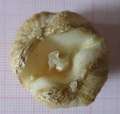Fritillaria acmopetala
Fritillaria acmopetala, the pointed-petal fritillary,[3] is a species of flowering plant in the lily family Liliaceae, native to rocky limestone mountain slopes in the Middle East. It was first described by Pierre Edmond Boissier in 1846.
| Fritillaria acmopetala | |
|---|---|
| Scientific classification | |
| Kingdom: | |
| (unranked): | |
| (unranked): | |
| Order: | |
| Family: | |
| Genus: | |
| Species: | F. acmopetala |
| Binomial name | |
| Fritillaria acmopetala | |
| Synonyms[2] | |
| |
Description
Fritillaria acmopetala is a bulbous perennial with an erect stem reaching heights of 30–70 cm (12–28 in). The long, straight, very narrow leaves grow in whorls about the lower stem and in pairs near the top. The stem has one or more nodding flowers at each node. The flower has six tepals, each 3 cm long. The outer ones are yellowish-green with some darker patches and red veins, the inner ones purplish brown at the top and bottom. The insides of both are yellow.[4][5] The bell-shaped flower flares out sharply at the mouth.[6]
There are two subspecies, Fritillaria acmopetala ssp. acmopetala and Fritillaria acmopetala ssp. wendelboi. The latter has broader leaves and is restricted to Southern Turkey[7]
Distribution and habitat
It is found in northern Cyprus, southern Turkey (Lycia to Cilicia) and the (Nur Dağları of the Hatay Province, Lebanon, Israel and Palestine.[8][9] It is found in the maquis, open woodland and in cornfields. The subspecies Fritillaria acmopetala ssp. Wendelboi grows in cedar woodland at higher altitudes.[10] In Cyprus, it grows in cornfields and under olive trees in the Girne-district, in the villages of Karaman and Edremit.[11]
Cultivation
The plant was introduced into cultivation in 1874.[6] It needs well-draining, fertile soil, like most fritillaries. The bulbs should be planted 10 cm (3.9 in) deep. In Britain, it flowers in early April and is fully hardy.[6] This plant has gained the Royal Horticultural Society's Award of Garden Merit.[3]
It is susceptible to predation by the red lily beetle (Lilioceris lilii) and can suffer from lily disease caused by the plant pathogenic fungus Botrytis elliptica.[3]
 Bulb
Bulb

References
- Tropicos, search for Fritillaria acmopetala
- Kew World Checklist of Selected Plant Families, synonym list for Fritillaria acmopetala subsp. acmopetala
- "Fritillaria acmopetala". www.rhs.org. Royal Horticultural Society. Retrieved 12 April 2020.
- Bou Khater, M. (2010). "Espèce: Fritillaria acmopetala Boiss". Lebanon Flora. Faculté des sciences Université Saint-Joseph de Beyrouth. Archived from the original on August 16, 2011. Retrieved May 4, 2011.
- Boissier, Pierre Edmond. 1846. Diagnoses Plantarum Orientalium novarum. Lipsiae ser. 1, 7: 104. According to Pavord, the inside is green
- Anna Pavord, Bulb. London, Mitchell Beazley 2009, 210
- Peter Sheasby, Bulbous plants of Turkey and Iran. Oxford, Information Press 2007, 119
- RHS A-Z Encyclopedia of Garden Plants. United Kingdom: Dorling Kindersley. 2008. p. 1136. ISBN 978-1405332965.
- Kew World Checklist of Selected Plant Families, name overview, Fritillaria acmopetala Boiss.
- Peter Sheasby, Bulbous plants of Turkey and Iran. Eynsham/Oxford, Information Press 2007, 119
- A. K. Jackson, W. B. Turrill, On the Flora of the Nearer East: XIX. Additions, etc., to the Flora of Cyprus. Bulletin of Miscellaneous Information Royal Gardens, Kew 1938/10, 467, Stable URL: https://www.jstor.org/stable/4113450
External links
| Wikimedia Commons has media related to Fritillaria acmopetala. |
- Fritillaria icones Illustration